University Assignment: Minimizing Biases in Performance Evaluation
VerifiedAdded on 2022/08/13
|6
|1447
|24
Report
AI Summary
This report delves into the intentional and unintentional biases that can distort performance evaluations. It identifies factors such as leniency, halo errors, and similarity errors as conscious biases, and recency and negativity biases as unconscious influences. The report analyzes a case study to highlight how these biases might manifest and suggests interventions to mitigate them. Recommendations include documenting expectations, using data analytics in hiring, and developing SWOT analyses of candidates to ensure a systematic and analytical rating process. The report emphasizes the importance of fair and objective evaluations, suggesting video interviews and diverse review panels to minimize subjective judgments and promote a more equitable assessment system.
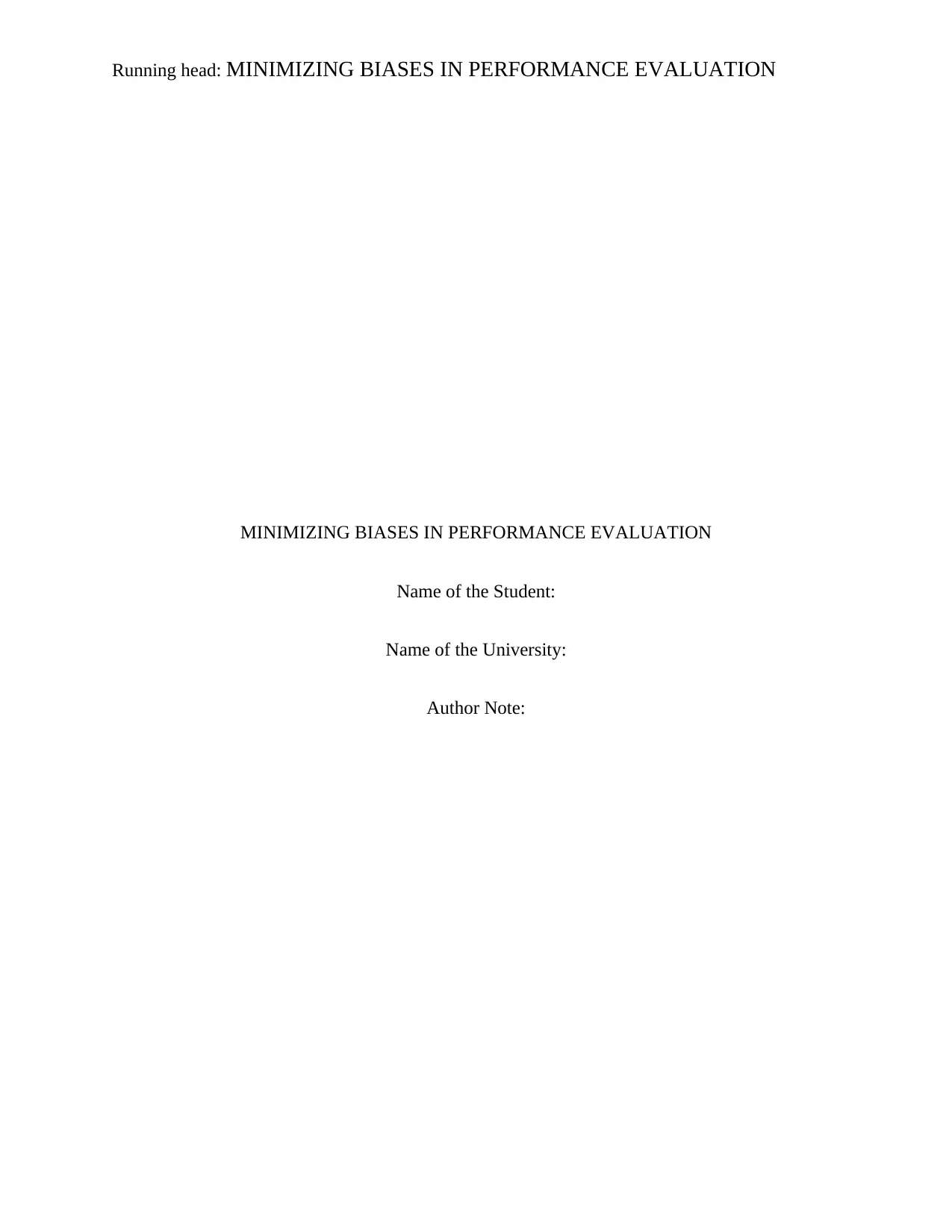
Running head: MINIMIZING BIASES IN PERFORMANCE EVALUATION
MINIMIZING BIASES IN PERFORMANCE EVALUATION
Name of the Student:
Name of the University:
Author Note:
MINIMIZING BIASES IN PERFORMANCE EVALUATION
Name of the Student:
Name of the University:
Author Note:
Paraphrase This Document
Need a fresh take? Get an instant paraphrase of this document with our AI Paraphraser
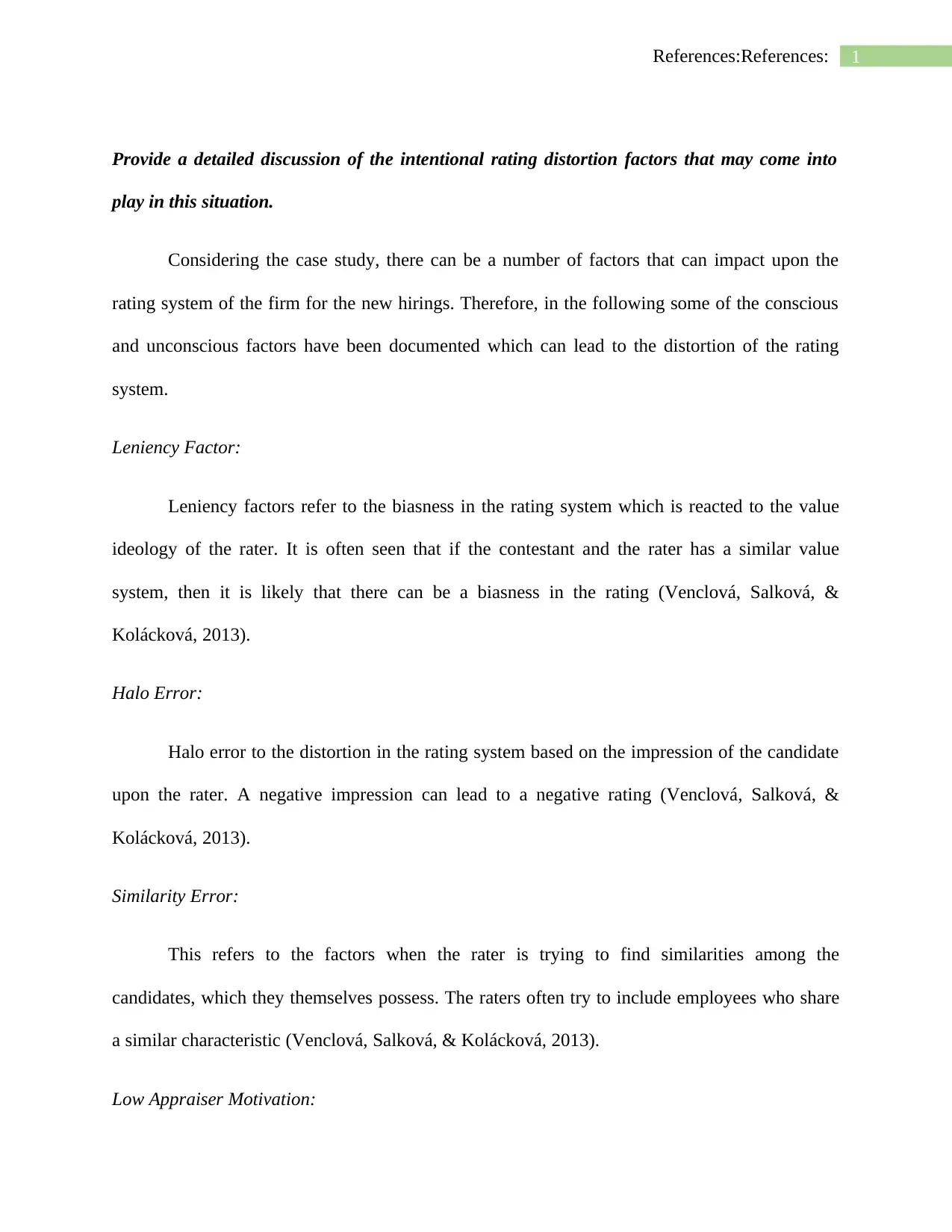
1References:References:
Provide a detailed discussion of the intentional rating distortion factors that may come into
play in this situation.
Considering the case study, there can be a number of factors that can impact upon the
rating system of the firm for the new hirings. Therefore, in the following some of the conscious
and unconscious factors have been documented which can lead to the distortion of the rating
system.
Leniency Factor:
Leniency factors refer to the biasness in the rating system which is reacted to the value
ideology of the rater. It is often seen that if the contestant and the rater has a similar value
system, then it is likely that there can be a biasness in the rating (Venclová, Salková, &
Kolácková, 2013).
Halo Error:
Halo error to the distortion in the rating system based on the impression of the candidate
upon the rater. A negative impression can lead to a negative rating (Venclová, Salková, &
Kolácková, 2013).
Similarity Error:
This refers to the factors when the rater is trying to find similarities among the
candidates, which they themselves possess. The raters often try to include employees who share
a similar characteristic (Venclová, Salková, & Kolácková, 2013).
Low Appraiser Motivation:
Provide a detailed discussion of the intentional rating distortion factors that may come into
play in this situation.
Considering the case study, there can be a number of factors that can impact upon the
rating system of the firm for the new hirings. Therefore, in the following some of the conscious
and unconscious factors have been documented which can lead to the distortion of the rating
system.
Leniency Factor:
Leniency factors refer to the biasness in the rating system which is reacted to the value
ideology of the rater. It is often seen that if the contestant and the rater has a similar value
system, then it is likely that there can be a biasness in the rating (Venclová, Salková, &
Kolácková, 2013).
Halo Error:
Halo error to the distortion in the rating system based on the impression of the candidate
upon the rater. A negative impression can lead to a negative rating (Venclová, Salková, &
Kolácková, 2013).
Similarity Error:
This refers to the factors when the rater is trying to find similarities among the
candidates, which they themselves possess. The raters often try to include employees who share
a similar characteristic (Venclová, Salková, & Kolácková, 2013).
Low Appraiser Motivation:
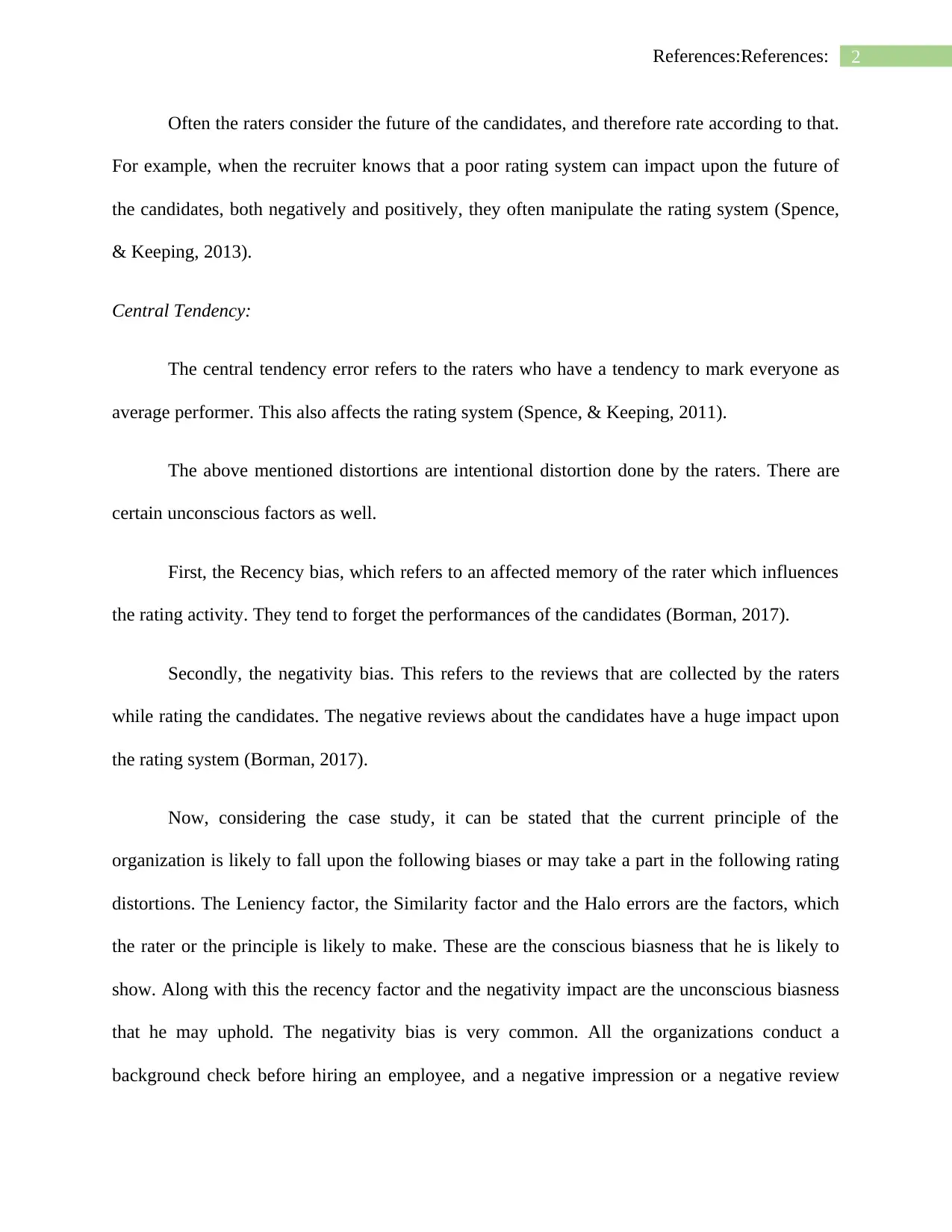
2References:References:
Often the raters consider the future of the candidates, and therefore rate according to that.
For example, when the recruiter knows that a poor rating system can impact upon the future of
the candidates, both negatively and positively, they often manipulate the rating system (Spence,
& Keeping, 2013).
Central Tendency:
The central tendency error refers to the raters who have a tendency to mark everyone as
average performer. This also affects the rating system (Spence, & Keeping, 2011).
The above mentioned distortions are intentional distortion done by the raters. There are
certain unconscious factors as well.
First, the Recency bias, which refers to an affected memory of the rater which influences
the rating activity. They tend to forget the performances of the candidates (Borman, 2017).
Secondly, the negativity bias. This refers to the reviews that are collected by the raters
while rating the candidates. The negative reviews about the candidates have a huge impact upon
the rating system (Borman, 2017).
Now, considering the case study, it can be stated that the current principle of the
organization is likely to fall upon the following biases or may take a part in the following rating
distortions. The Leniency factor, the Similarity factor and the Halo errors are the factors, which
the rater or the principle is likely to make. These are the conscious biasness that he is likely to
show. Along with this the recency factor and the negativity impact are the unconscious biasness
that he may uphold. The negativity bias is very common. All the organizations conduct a
background check before hiring an employee, and a negative impression or a negative review
Often the raters consider the future of the candidates, and therefore rate according to that.
For example, when the recruiter knows that a poor rating system can impact upon the future of
the candidates, both negatively and positively, they often manipulate the rating system (Spence,
& Keeping, 2013).
Central Tendency:
The central tendency error refers to the raters who have a tendency to mark everyone as
average performer. This also affects the rating system (Spence, & Keeping, 2011).
The above mentioned distortions are intentional distortion done by the raters. There are
certain unconscious factors as well.
First, the Recency bias, which refers to an affected memory of the rater which influences
the rating activity. They tend to forget the performances of the candidates (Borman, 2017).
Secondly, the negativity bias. This refers to the reviews that are collected by the raters
while rating the candidates. The negative reviews about the candidates have a huge impact upon
the rating system (Borman, 2017).
Now, considering the case study, it can be stated that the current principle of the
organization is likely to fall upon the following biases or may take a part in the following rating
distortions. The Leniency factor, the Similarity factor and the Halo errors are the factors, which
the rater or the principle is likely to make. These are the conscious biasness that he is likely to
show. Along with this the recency factor and the negativity impact are the unconscious biasness
that he may uphold. The negativity bias is very common. All the organizations conduct a
background check before hiring an employee, and a negative impression or a negative review
⊘ This is a preview!⊘
Do you want full access?
Subscribe today to unlock all pages.

Trusted by 1+ million students worldwide
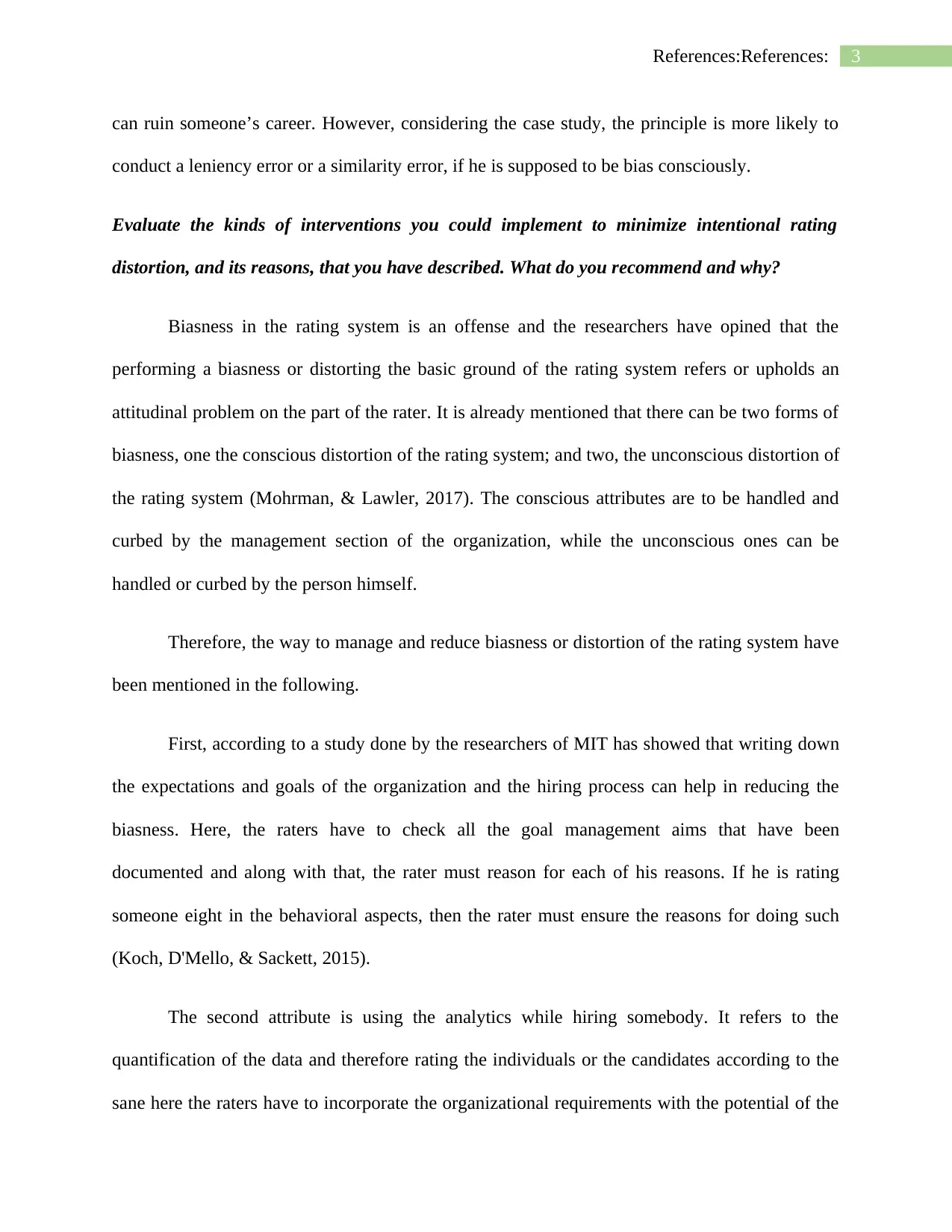
3References:References:
can ruin someone’s career. However, considering the case study, the principle is more likely to
conduct a leniency error or a similarity error, if he is supposed to be bias consciously.
Evaluate the kinds of interventions you could implement to minimize intentional rating
distortion, and its reasons, that you have described. What do you recommend and why?
Biasness in the rating system is an offense and the researchers have opined that the
performing a biasness or distorting the basic ground of the rating system refers or upholds an
attitudinal problem on the part of the rater. It is already mentioned that there can be two forms of
biasness, one the conscious distortion of the rating system; and two, the unconscious distortion of
the rating system (Mohrman, & Lawler, 2017). The conscious attributes are to be handled and
curbed by the management section of the organization, while the unconscious ones can be
handled or curbed by the person himself.
Therefore, the way to manage and reduce biasness or distortion of the rating system have
been mentioned in the following.
First, according to a study done by the researchers of MIT has showed that writing down
the expectations and goals of the organization and the hiring process can help in reducing the
biasness. Here, the raters have to check all the goal management aims that have been
documented and along with that, the rater must reason for each of his reasons. If he is rating
someone eight in the behavioral aspects, then the rater must ensure the reasons for doing such
(Koch, D'Mello, & Sackett, 2015).
The second attribute is using the analytics while hiring somebody. It refers to the
quantification of the data and therefore rating the individuals or the candidates according to the
sane here the raters have to incorporate the organizational requirements with the potential of the
can ruin someone’s career. However, considering the case study, the principle is more likely to
conduct a leniency error or a similarity error, if he is supposed to be bias consciously.
Evaluate the kinds of interventions you could implement to minimize intentional rating
distortion, and its reasons, that you have described. What do you recommend and why?
Biasness in the rating system is an offense and the researchers have opined that the
performing a biasness or distorting the basic ground of the rating system refers or upholds an
attitudinal problem on the part of the rater. It is already mentioned that there can be two forms of
biasness, one the conscious distortion of the rating system; and two, the unconscious distortion of
the rating system (Mohrman, & Lawler, 2017). The conscious attributes are to be handled and
curbed by the management section of the organization, while the unconscious ones can be
handled or curbed by the person himself.
Therefore, the way to manage and reduce biasness or distortion of the rating system have
been mentioned in the following.
First, according to a study done by the researchers of MIT has showed that writing down
the expectations and goals of the organization and the hiring process can help in reducing the
biasness. Here, the raters have to check all the goal management aims that have been
documented and along with that, the rater must reason for each of his reasons. If he is rating
someone eight in the behavioral aspects, then the rater must ensure the reasons for doing such
(Koch, D'Mello, & Sackett, 2015).
The second attribute is using the analytics while hiring somebody. It refers to the
quantification of the data and therefore rating the individuals or the candidates according to the
sane here the raters have to incorporate the organizational requirements with the potential of the
Paraphrase This Document
Need a fresh take? Get an instant paraphrase of this document with our AI Paraphraser
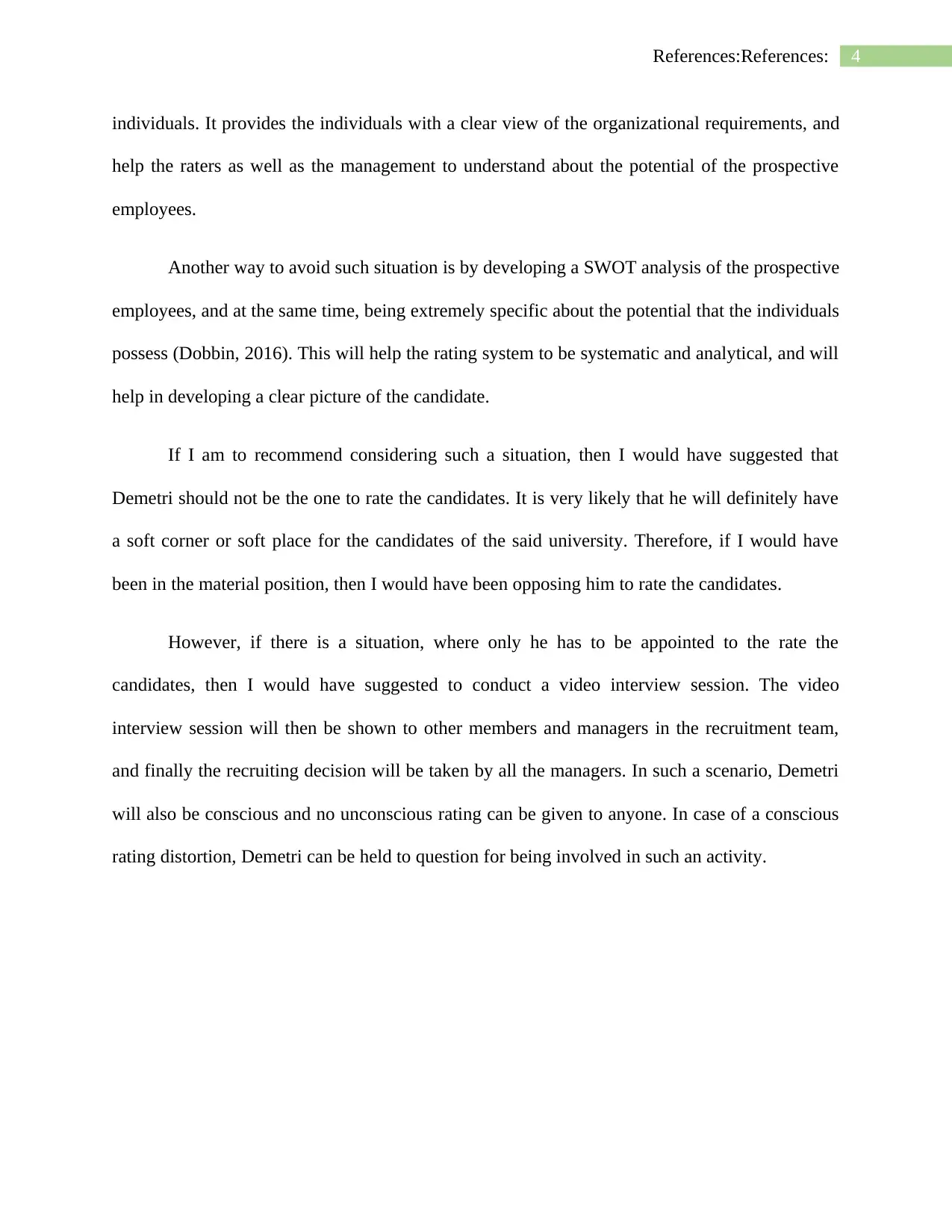
4References:References:
individuals. It provides the individuals with a clear view of the organizational requirements, and
help the raters as well as the management to understand about the potential of the prospective
employees.
Another way to avoid such situation is by developing a SWOT analysis of the prospective
employees, and at the same time, being extremely specific about the potential that the individuals
possess (Dobbin, 2016). This will help the rating system to be systematic and analytical, and will
help in developing a clear picture of the candidate.
If I am to recommend considering such a situation, then I would have suggested that
Demetri should not be the one to rate the candidates. It is very likely that he will definitely have
a soft corner or soft place for the candidates of the said university. Therefore, if I would have
been in the material position, then I would have been opposing him to rate the candidates.
However, if there is a situation, where only he has to be appointed to the rate the
candidates, then I would have suggested to conduct a video interview session. The video
interview session will then be shown to other members and managers in the recruitment team,
and finally the recruiting decision will be taken by all the managers. In such a scenario, Demetri
will also be conscious and no unconscious rating can be given to anyone. In case of a conscious
rating distortion, Demetri can be held to question for being involved in such an activity.
individuals. It provides the individuals with a clear view of the organizational requirements, and
help the raters as well as the management to understand about the potential of the prospective
employees.
Another way to avoid such situation is by developing a SWOT analysis of the prospective
employees, and at the same time, being extremely specific about the potential that the individuals
possess (Dobbin, 2016). This will help the rating system to be systematic and analytical, and will
help in developing a clear picture of the candidate.
If I am to recommend considering such a situation, then I would have suggested that
Demetri should not be the one to rate the candidates. It is very likely that he will definitely have
a soft corner or soft place for the candidates of the said university. Therefore, if I would have
been in the material position, then I would have been opposing him to rate the candidates.
However, if there is a situation, where only he has to be appointed to the rate the
candidates, then I would have suggested to conduct a video interview session. The video
interview session will then be shown to other members and managers in the recruitment team,
and finally the recruiting decision will be taken by all the managers. In such a scenario, Demetri
will also be conscious and no unconscious rating can be given to anyone. In case of a conscious
rating distortion, Demetri can be held to question for being involved in such an activity.
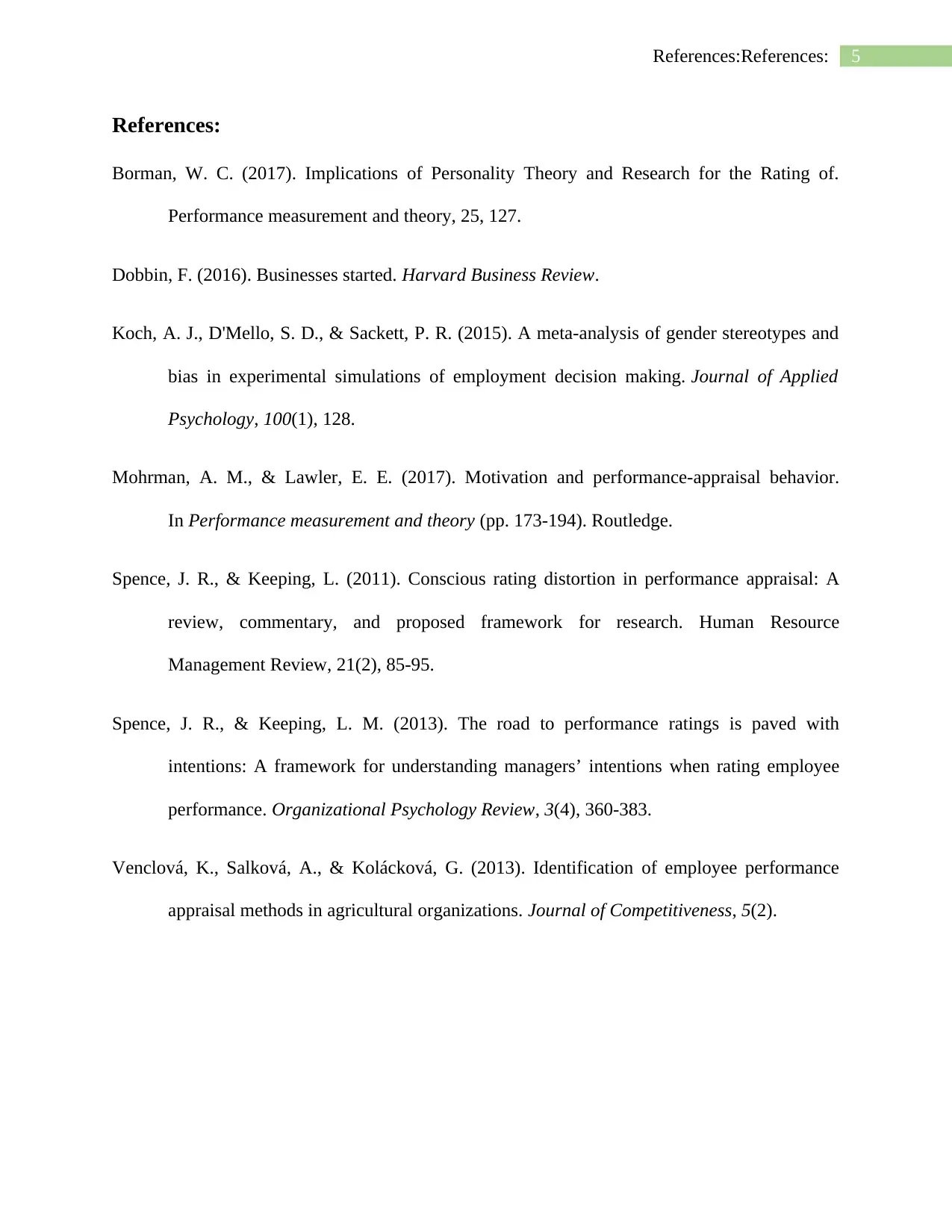
5References:References:
References:
Borman, W. C. (2017). Implications of Personality Theory and Research for the Rating of.
Performance measurement and theory, 25, 127.
Dobbin, F. (2016). Businesses started. Harvard Business Review.
Koch, A. J., D'Mello, S. D., & Sackett, P. R. (2015). A meta-analysis of gender stereotypes and
bias in experimental simulations of employment decision making. Journal of Applied
Psychology, 100(1), 128.
Mohrman, A. M., & Lawler, E. E. (2017). Motivation and performance-appraisal behavior.
In Performance measurement and theory (pp. 173-194). Routledge.
Spence, J. R., & Keeping, L. (2011). Conscious rating distortion in performance appraisal: A
review, commentary, and proposed framework for research. Human Resource
Management Review, 21(2), 85-95.
Spence, J. R., & Keeping, L. M. (2013). The road to performance ratings is paved with
intentions: A framework for understanding managers’ intentions when rating employee
performance. Organizational Psychology Review, 3(4), 360-383.
Venclová, K., Salková, A., & Kolácková, G. (2013). Identification of employee performance
appraisal methods in agricultural organizations. Journal of Competitiveness, 5(2).
References:
Borman, W. C. (2017). Implications of Personality Theory and Research for the Rating of.
Performance measurement and theory, 25, 127.
Dobbin, F. (2016). Businesses started. Harvard Business Review.
Koch, A. J., D'Mello, S. D., & Sackett, P. R. (2015). A meta-analysis of gender stereotypes and
bias in experimental simulations of employment decision making. Journal of Applied
Psychology, 100(1), 128.
Mohrman, A. M., & Lawler, E. E. (2017). Motivation and performance-appraisal behavior.
In Performance measurement and theory (pp. 173-194). Routledge.
Spence, J. R., & Keeping, L. (2011). Conscious rating distortion in performance appraisal: A
review, commentary, and proposed framework for research. Human Resource
Management Review, 21(2), 85-95.
Spence, J. R., & Keeping, L. M. (2013). The road to performance ratings is paved with
intentions: A framework for understanding managers’ intentions when rating employee
performance. Organizational Psychology Review, 3(4), 360-383.
Venclová, K., Salková, A., & Kolácková, G. (2013). Identification of employee performance
appraisal methods in agricultural organizations. Journal of Competitiveness, 5(2).
⊘ This is a preview!⊘
Do you want full access?
Subscribe today to unlock all pages.

Trusted by 1+ million students worldwide
1 out of 6
Related Documents
Your All-in-One AI-Powered Toolkit for Academic Success.
+13062052269
info@desklib.com
Available 24*7 on WhatsApp / Email
![[object Object]](/_next/static/media/star-bottom.7253800d.svg)
Unlock your academic potential
Copyright © 2020–2025 A2Z Services. All Rights Reserved. Developed and managed by ZUCOL.




